| Wednesday,
April 12, 2006, 7:20 am
Hello from Cuernavaca - The Most Intense
Day of my Trip - Studying Spanish, 3 interviews, an eco- hike in
the woods and dinner downtown
I have a habit of cramming a few too many things into my schedule,
and I think yesterday was such a day.
I started my day with a nice breakfast and then took a taxi to
the Cetlalic language school.
Cetlalic is known for its dedication to political activism and strongly
supports the causes of indigenous people, women, gays and lesbians
and other marginalized minorities.
My two co-students from Germany, my teacher Mario and I had a very
interesting conversation about Mexico and its political system.
He explained the 3 major political parties (PAN, PRI, PRD), two
of which are rightist parties, and the last of which is leftist.
In 1988 apparently there was an election scandal, where the PRD
party was leading, but for 20 minutes all the computers experienced
a failure counting the votes, and when the TV cameras returned to
the vote counting process, the PAN party was suddenly in the lead
and ended up winning the election. This echoes many of the comments
about political corruption that I have been hearing widely from
people in all walks of life here.
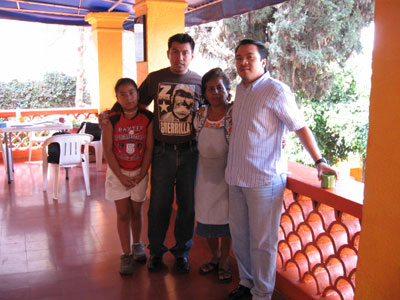
My teacher Mario (second from left) on the balcony where we had
our lessons
Mexico is an interesting country, since I am here I have heard
a multitude of people refer to the entrenched corruption that is
part of the way of doing things here. The term “mordida”
means “bribe”, and a mordida might be required when
you get stopped by a policeman on the highway or when a large international
company might want to build a shopping centre in a historically
significant part of town that might affect archeological sites.
A variety of people have commented that many politicians start
out poor, but end up being millionaires by the time they leave office,
and confidence in the political system is generally low. This is
particularly interesting since national elections are coming up
on July 2 of this year. By the way, the Mexican presidency is only
elected every 6 years.
Our teacher went on to tell us some examples of active local citizen
resistence where village residents prevented a gas station from
being built., using a variety of tactics. To this day the fully
functional gas station has never been put into operation.
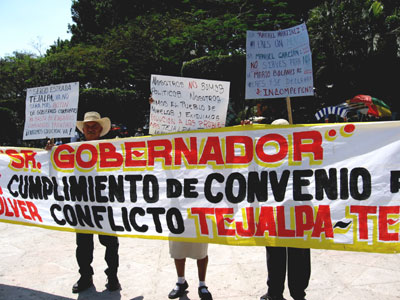
A local protest regarding development and access to water
After this interesting 2 hour discussion, we returned again to
more mundane Spanish grammar topics such as the difference between
ser and estar, and we practiced how to form conditional
sentences, using the beloved Spanish subjunctive.
At noon it was time again for my other explorations while my colleagues
with their Spanish practice. I had a meeting with a young gentleman
by the name of Ruben
Cortes who runs a local adventure travel and sightseeing company
as well as a local budget hotel. When we met he told me that he
has a degree in international commerce, and that he just loves outdoor
activities. His company provides sightseeing tours, guided tours
to local museums, a variety of outdoor adventure activities (hiking,
mountain climbing, rafting, rappelling, SCUBA diving – they
are certified PADI scuba diving instructors) and many more.
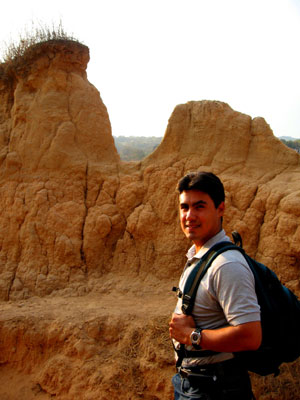
Ruben Cortes during our nature hike
The Mexican State of Morelos is a wonderful area for nature lovers
and outdoor adventurers. There are a variety of mountains, most
of which are former volcanoes, and the region offers boundless nature
adventure opportunities. His family’s hotel, the Hotel
Royal, is located right in Downtown Cuernavaca and offers budget
accommodation between 240 and 350 pesos a night in simple hotel
rooms with TV and private bathrooms. After the interview was finished,
Ruben suggested that we meet later on today and that he would give
me a sample of his services in the form of a brief hike through
a nature area on the outskirts of town.
At 2:30 I had my next interview. I met Pablo Buitron from a local
non-profit organization called “Fundacion
Communidad”. Pablo has a doctorate in management from
the University of Texas as well as an MBA from the University of
Buffalo, NY, so he speaks excellent English. His non-profit organization
focuses on fundraising for local community projects and for supporting
micro-business activities. The interesting thing in his business
is that he focuses on his community’s assets (rather than
on the “problems”), and that to him the term "community"
is far more important than the term "market".
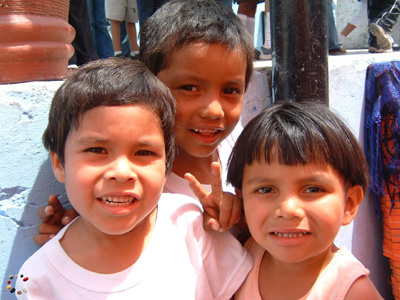
Picture from one of Fundacion Comunidad's community initiatives
Pablo and I had a great connection, we both have business backgrounds,
but we both believe in the importance of social enterprise and real
entrepreneurial responsibility to our communities. Pablo mentioned
that since the inception of his organization, they have raised funds
in the neighbourhood of 15,000,000 pesos (about US$1.5 million)
and more than 40,000 people have benefited from their programs.
Apparently, 90% of the people they work with are women and he says
in his opinion by far the greatest change in Mexico’s culture
has taken place in the last 50 years in terms of the status of women.
At the same time he admits that the status of women in Mexico, particularly
in the rural areas, can be 100 years behind other countries.
Pablo was kind enough to drop me off downtown at an Internet café
and after that I made my way to the next appointment: Casa
Vamos. Casa Vamos is a non-profit organization funded by a couple
from Vermont who had fallen in love with Mexico and its people and
who wanted to do something about the poverty that still exists in
its country.
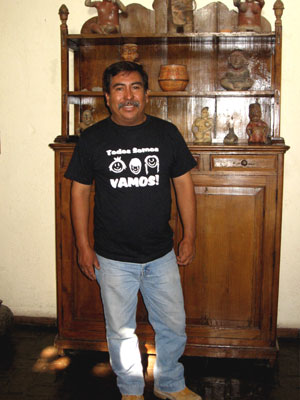
Agustin, from Casa Vamos
So I went to the beautiful mansion that Casa
Vamos runs on Francisco Leyva Street and sat down with its caretaker
Agustín to chat. I was also supposed to meet a gentleman
by the name of Alejandro who is the executive director of the organization,
but unfortunately he had had a car accident and wasn’t able
to make it. Agustín was kind enough to give me a brief overview
of his organization, that they have more than 20 projects that help
children, adults and older people who need it the most. For now,
Casa Vamos, the mansion, is used to generate funds for the non-profit
foundation. It’s a very unique concept: Casa Vamos is run
like a bed and breakfast, it has 4 guest rooms, all very large with
private bathrooms, in a wonderful stylishly decorated mansion. The
price is reasonable, between $50 and $100 per night, and all revenue
goes to the charitable foundation.
Agustín also told me that even though he is an agronomy
engineer, he spent five years in local mountain villages as a social
worker, helping the poor people and in the 5 years he was there,
the mortality rate in this particular location went from 80% to
less than 30%. His work made a huge difference in the community
and whenever he goes back to visit them, and he does so frequently
since he gets invited to weddings and other functions, all the local
inhabitants welcome him enthusiastically and show their appreciation
for the help he gave them. Whenever Agustín talks about this
time in his life, his eyes light up and it is obvious how much this
time meant to him. He is very happy to have an opportunity now with
Casa Vamos, so he can continue to make a difference in the community.
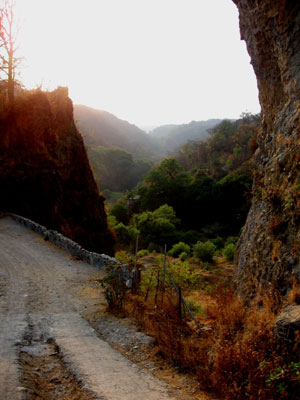
A view of the Barranca de Santa Maria as the sun starts
to go down
Roughly around 6 pm my adventure travel specialist Ruben
came to pick me up and we drove from the central area of town to
the outskirts on the north to go on our eco-hiking adventure. We
went to an area called Santa Maria, and on the way Ruben pointed
out all major points of interest. I asked him how come he knows
so much about the city and he indicated that since his company provides
tour-guiding services as well, he spent a lot of time educating
himself about the city, its history and its natural environment.
He even consulted some local archives and historians.
The Santa Maria area is a rather poor area and was an independent
village prior to being gobbled up by Cuernavaca. We parked the car
and hiked down into a barranca (ravine) with a river at
the bottom. Cuernavaca is located in the shadow of several ancient
inactive volcanos and the soil is made up of conglomerate material.
Many small rivers come down from the mountain tops, and the water’s
erosion has created more than 70 ravines in Cuernavaca – certainly
the most predominant topographical features of this town. There
is apparently only one street in town that is level (built under
the dictator Porfirio Diaz), all other streets are at an incline
due to the topography.
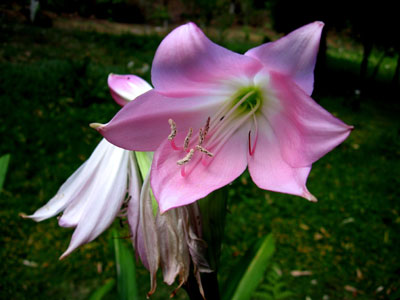
Beautiful flowers in this ravine
Ruben explained that houses have been built without permits in
many of Cuernavaca’s ravines, and the people that live there
have no sewer systems, no access to the city’s water system.
As far as electricity is concerned they tap into the power system
illegally. The city can’t do much since it is unable to rehouse
these people after a possible eviction.
Similarly, Cuernavaca used to have a railroad which has since been
abandoned in the last 10 years. The steel of the railway tracks
was removed and sold off, and local people came and settled in the
former railway corridor, of course without building permits. Again,
the government can’t really do much about these settlements.
Once we arrived at the bottom of the barranca, we saw
a local family doing their laundry. They live in very poor conditions
and don’t have washing machines, so whenever necessary, they
take all their dirty laundry, come to the river, wash everything
by hand and dry it on a string hung between two trees. Definitely
a full day endeavour.
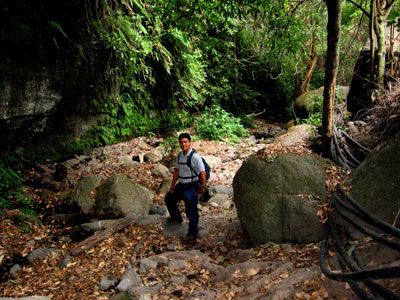
Ruben, my eco-hiking guide
Ruben and I hiked on and he explained the different climactic zones
and the variety of trees. There is a temperate zone and above that
is a coniferous zone with a great variety of plants, animals and
birds. We made our way forward around roots and rocks beside the
river bed. In this part of the river the water is totally clear
and local people capture it in long rubber pipes (hundreds of meters
long) that run beside the river bed and then lead up to their houses.
Again, they tap into the water on their own since they don’t
have access to any government-provided water system. As we continued
we walked past 2 trout farms that cultivate fresh-water fish for
commercial purposes. After about 45 minutes we arrived at a cascada
– a fully enclosed mountain wall that normally has a waterfall,
but since it is dry season right now there was no water cascading
down the rock wall.
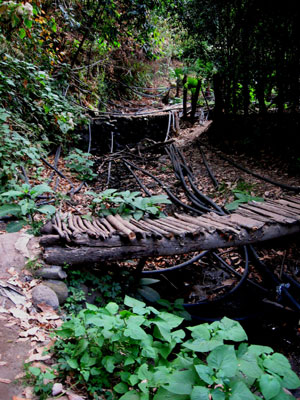
Rubber pipes supply water to local people
Here was the end of our walk, so we turned around to make our way
back. We stopped at the first trout farm to talk to the owner Javier.
He cultivates trout in this very remote location without road access.
In addition he runs a restaurant from here, so that means he always
has to pick up his supplies (beer, drinks, food, etc.) and carry
them on his back to his restaurant. Equally he has to carry his
merchandise – freshly caught trout – out of this area
for 1.5 kilometers to transport it to local markets. He mentioned
that he regularly carries loads of 50 kg and although he has a rather
slight build, many other people have said that they would never
be able or want to do all the physical work that he does, but Javier
loves it.
Interestingly, Javier comes from an urban family that has always
owned businesses, and he used to run his family’s company
in the city before he moved out to this remote area. Javier is very
happy when he talks about his business, and he has found his niche
hidden away amongst the foliage of the Barranca de Santa Maria.
On our way we saw some beautiful flowers, trees and royal palms.
The family that we had seen earlier had finished doing their laundry
and Ruben was kind enough to ask them if they were willing to have
their picture taken and they agreed. We chatted a bit and they said
that doing their laundry is pretty much a full-day activity and
they have to carry everything in and out.
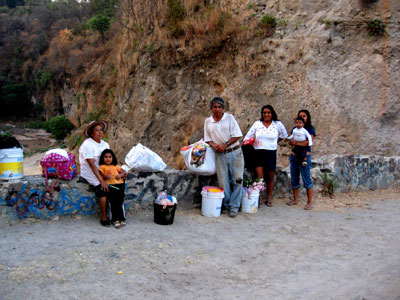
The family returns from washing their laundry in the river
We saw a beautiful evening sky when we made our way back to Ruben’s
car and the whole area had such a pristine feel to it. Ruben explained
that interest in nature in Mexico is still in its infancy. In all
of Mexico City (25 million people) there are only 4 stores that
sell tents and outdoor equipment. People are more enchanted with
football and baseball and environmental awareness barely exists
yet, as evidenced by traces of garbage that can be found in many
nature areas.
Ruben's interest in nature was awakened when he went on a trip
to Canada’s West Coast and fell in love with hiking and nature
exploration. He also said that Mexico is a haven for bird-watchers,
although local residents have no interest in that activity.
After our 1.5 hour hike he dropped me off downtown so I could have
a nice little dinner. On the way to the city centre he pointed out
to me the oldest church in Latin America which was built in 1525.
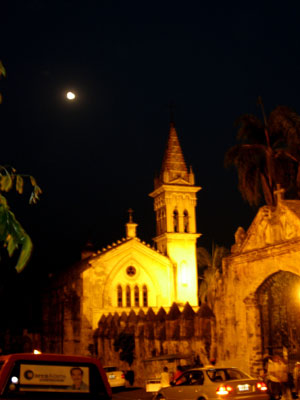
One of Cuernavaca's chapels at night, across from the Marco Polo
Restaurant
He dropped me off right across from the cathedral at the famous
Marco Polo Restaurant where I was looking foward to an Italian dinner.
I hadn’t really eaten much all day, so this was going to be
a nice way to end an extremely compact day. Unfortunately all the
seats on the outside balcony facing the beautiful lit-up church
were taken, but they gave me a nice table facing the interior courtyard.
I had a delicious Stracchiatella Soup and a simple Ensalata Mista.
After that I walked past the Palacio de Cortés where there
was all sorts of street life and I hopped into a bus to get back
to where I was staying. I had a very nice chat with my host Cinthia’s
family and told them about my compact day.
Sometimes I can’t believe how much I manage to cram into
my day, but this one was definitely up there….
Useful Books:
Related Articles:
Mexico 2006 - My cultural immersion
experiment
Hello from Mexico City - First impressions
Hello from Mexico City - A skyscraper,
a little horse and a government pawn shop
Hello from Mexico City - The Zócalo,
the Cathedral, a healing ritual and a university dedicated to a
16th century female poet
Hello from Mexico City - A relaxing
evening in Coyoacán
Hello from Mexico City - Exploring the
Paseo de la Reforma, de Bosque de Chapúltepec and a nice
evening in San Angel
Hello from Cuernavaca - Arrival and
first impressions
Hello from Cuernavaca - Getting to know
my B&B hostess Marta Elena: A true riches to rags story
Hello from Cuernavaca - My first day
learning Spanish and two local icons: the Robert Brady Museum and
the Jardín Borda
Hello from Cuernavaca - A lovely dinner
in a garden paradise
Hello from Cuernavaca - An excursion
to Las Estacas, checking out orchids and a meeting at El Cafecito
Hello from Cuernavaca - An excursion
to Lake Tequesquitengo and a visit to the doctor
Hello from Cuernavaca - A conversation
with Andy Grater, local B&B owner and President of the Newcomers
Club
Hello from Cuernavaca - A presentation
about ecology at the Newcomers Club Meeting
Hello from Cuernavaca - Opening of a
South African photo exhibition and a visit to the Palacio de Cortés
Hello from Taxco - The city that silver built
Hello from Taxco during Semana Santa - The
famous Palm Sunday Procession
Hello from Cuernavaca - A new language
school, visiting 'Casa Vamos' and an evening with a very sad ending
Hello from Cuernavaca - My most intense
day: more language studies, 3 interviews, a guided eco-hike and
dinner at the Marco Polo
Hello from Cuernavaca - A day outing
to the enchanting mythical village of Tepoztlan
Hello from Cuernavaca - My last day
of school and a visit to Cuernavaca's Spring Fair
Hello from Taxco - An eerie experience: Visiting
Taxco's famous Good Friday procession
Hello from Taxco and Cuernavaca - Interviewing
one of the penitentes and enjoying my last day in Mexico
Related Interviews:
Presenting:
Ruben Córtes from Morelos Trails - Local adventure sports
and cultural guided tour operator, expert on Morelos and Cuernavaca
Presenting: Pablo
Buitrón from Fundacion Comunidad, helping local
women empower themselves
Presenting: Jorge Torres from
the Cetlalic Alternative Language School - Learning Spanish with
cultural, social and political awareness
Presenting: Hermilo Brito
from the Ideal Language School - Making Spanish learning fun
Helpful links:
Mexico
Tourism Information
State
of Morelos Tourism Organization
Official
website of the City of Cuernavaca tourism
|